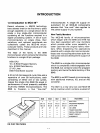
INTRODUCTION
processor to perform arithmetic manipu-
lations on the data it obtains from memory
and from its other inputs.
Using only the basic adder a capable
programmer can write routines which will
subtract, multiply and divide, giving. the
machine complete arithmetic capabilities.
In
practice, however, most ALUs provide
other built-in functions, including boolean
logic operations, and shift capabilities.
The ALU contains Flag Bits which specify
certain conditions that arise
in
the course
of
arithmetic and logical manipulations. It is
possible to program jumps which are
conditionally dependent on the status
of
one
or
more flags. Thus, for example, the
program may
be
designed to jump to a
special routine
if
the carry bit is set following
an
addition instruction.
Control Circuitry
The control circuitry
is
the primary functional
unit within a CPU. Using clock inputs, the
control circuitry maintains the proper se-
quence of events required for any processing
task. After
an
instruction
is
fetched and
decoded, the control circuitry issues the
appropriate signals (to units both internal
and external to the CPU) for initiating the
proper processing action.
Often the control
circuitry will
be
capable
of
responding to
external signals, such
as
an
interrupt. An
Interrupt request will cause the control
circuitry to temporarily interrupt main pro-
gram execution, jump to a special routine to
service the interrupting device, then auto-
matically return to the main program.
1.1.3 Computer Operations
There are certain operations that are basic to
almost any computer. A sound understand-
ing
of
these basic operations
is
a necessary
prerequisite to examining the specific
operations of a particular computer.
Timing
The activities of the central processor are
cyclical. The processor fetches
an
instruc-
tion, performs the operations required,
1-8
fetches the next instruction, and so on. This
orderly sequence
of
events requires precise
timing, and the CPU therefore requires a free
running oscillator clock which furnishes the
reference for all processor actions. The
combined fetch and execution
of
a single
instruction
is
referred to
as
an
Instruction
Cycle. The portion
of
a cycle identified with a
clearly defined activity
is
called a State. And
the interval between pulses
of
the timing
oscillator
is
referred to
as
a Clock Period. As
a general rule, one
or
more clock periods are
necessary for the completion
of
a state, and
there are several states in a cycle.
Instruction Fetch
The first state(s) of any instruction cycle will
be
dedicated to fetching the next instruction.
The CPU issues a read signal and the
contents of the program counter are sent to
program memory, which responds by
returning the next instruction word. The first
byte of the instruction
is
placed
in
the
instruction register. If the instruction con-
sists
of
more than one byte, additional states
are required to fetch the second byte
of
the
instruction. When the entire instruction
is
present
in
the CPU, the program counter
is
incremented (in preparation for the next
instruction fetch) and the instruction
is
decoded. The operation specified
in
the
instruction will
be
executed
ih
the remaining
states of the instruction cycle. The instruc-
tion may call for a data memory read
or
write,
an
input
or
output and/or
an
internal CPU
operation, such
as
a register-to-register
transfer
or
an
add operation.
Memory Read
An instruction fetch
is
merely a special
program memory read operation that brings
the instruction to the CPU's instruction
register. The instruction fetched may then
call for data to
be read from data memory
into the CPU. The CPU again issues a read
signal and sends the proper memory
address; memory responds by returning the
requested word. The data received
is
placed
in
the accumulator
or
one of the other
geheral purpose registers (not the instruc-
tion register).


















